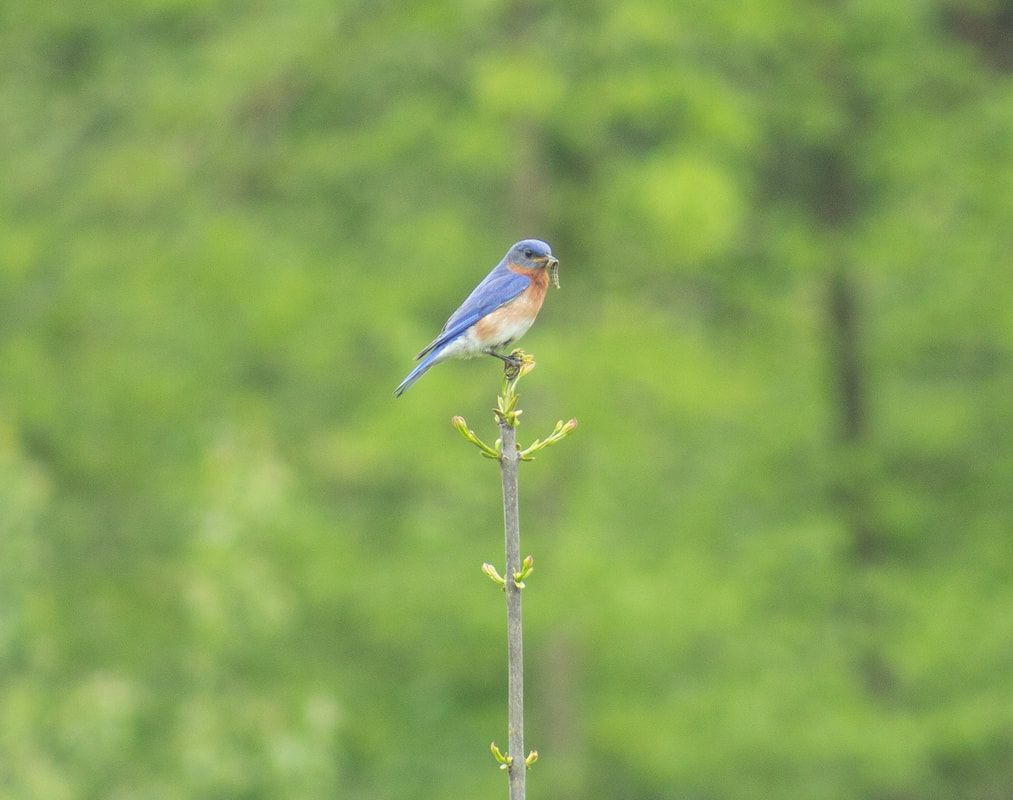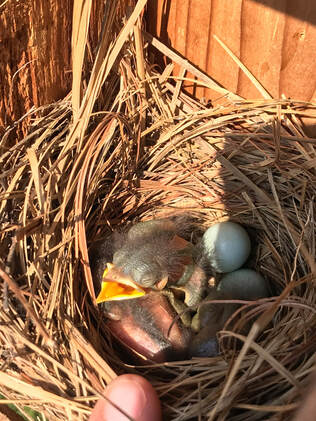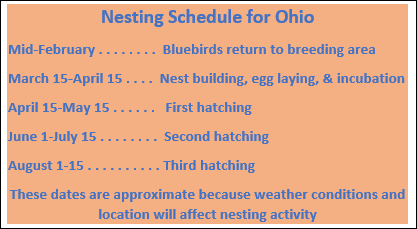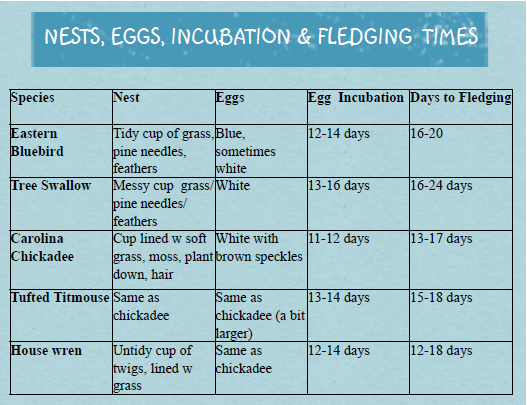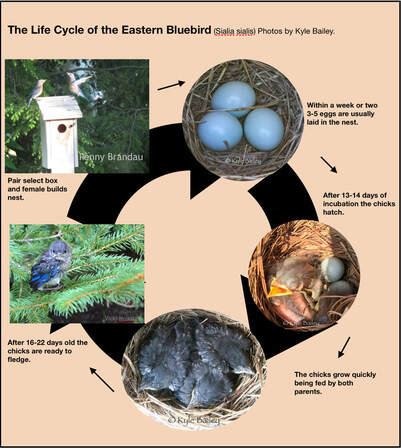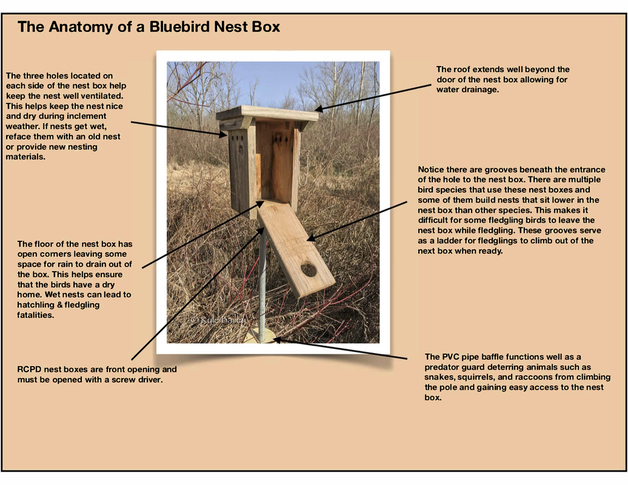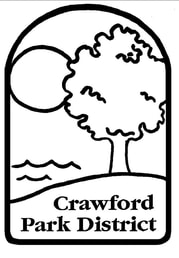Bluebird Monitoring
Eastern Bluebird Natural History
|
The Eastern Bluebird (Sialia sialis) is a small, charming, charismatic songbird in the Thrush Family, along with other common birds such as the American Robin (Turdus migratorius), Wood Thrush (Hylocichla mustelina), and Veery (Catharus fuscescens). Males are easily identifiable with their strikingly vivid, deep royal blue plumage above, rusty orange/red chest, and white belly. Females are paler overall with a grayish/blue coloration above and subdued rusty orange/brown chest.
Eastern Bluebirds are primarily medium-distance migratory birds; however, some birds may be year-round residents. Their range extends from Canada during summer months down into Southern U.S or Mexico during cooler months. Birds in the northern reaches of their range will always migrate south during winter, while more southern latitude nesting Bluebirds may migrate a short distance south to winter or reside locally in their breeding territory year-round. Like most Thrushes, Bluebirds are insectivorous birds that feed primarily on a diverse array of invertebrates including (caterpillars, grasshoppers, crickets, katydids, beetles, and spiders) among others. Like many other bird species, Bluebirds often can be found feeding on a wide variety of berries such as (sumac, black cherry, dogwood, pokeberries, hackberries, and blackberries). Unlike other birds that regularly visit bird feeders, Bluebirds prefer a flat surface; therefore, they are known as platform feeders. Eastern Bluebirds prefer open habitats that have trees or nest boxes to provide cavities for nesting, but do not have a dominant shrub understory. Ideal habitats include open woodlands, meadows, prairies, and orchards. In Ohio, they can be found any time of the year. Although, many migrate south for the winter, some will stick around and gather in large flocks. Flocking together is advantageous because singular birds do not have to work as hard during harsh conditions searching for food, water, shelter, and avoiding predators. Eastern Bluebirds are secondary cavity nesters, meaning they are not capable of creating their own cavities, so they rely on other animals such as Woodpeckers and other natural events to create cavities for them. |
Reasons for Population Decline
In the early 1900's, Bluebirds were one of Ohio's most commonly encountered rural birds. Then between 1920-1970 Bluebird populations dwindled to alarmingly low numbers. A bird that once was so common became a rare sight to behold. There were many contributing factors, particularly imprudent anthropogenic events along with a series of severe winters, resulting in a population decline of up to 90%. Extensive land clearing for agriculture and expansive housing development due to the ever increasing urban sprawl into rural areas led to a decrease in trees and open areas resulting in a decrease in natural cavities and ideal habitat. Over time, wooden fence posts that used to provide cavities for bluebirds and other cavity nesting species alike were replaced with metal posts. The introduction of herbicides and pesticides, forest management techniques/philosophies (removing dead trees/snags), and the increase in feral cat populations also all were significant factors that contributed to Bluebird population declines.
However, the biggest detriment to Bluebird population decline can be attributed to the introduction of non-native bird species; House Sparrows (Passer domesticus) and European Starlings (Sturnus vulgaris). Both House Sparrows and European Starlings are cavity nesters and both species are highly adaptable, aggressive birds. These non-native birds outcompete native species for space. House Sparrows are small enough to fit into any size cavity that a Bluebird can and they will always chase and attempt to kill young and adults. Starlings are larger than Bluebirds. When the right precautions are taken when installing artificial nest boxes for Bluebirds, assuring the entrance hole is just the right size, Starlings can be deterred from intervening. Natural cavities present more opportunities for these non-native species to harass Bluebirds because Woodpeckers tend to create large cavities.
However, the biggest detriment to Bluebird population decline can be attributed to the introduction of non-native bird species; House Sparrows (Passer domesticus) and European Starlings (Sturnus vulgaris). Both House Sparrows and European Starlings are cavity nesters and both species are highly adaptable, aggressive birds. These non-native birds outcompete native species for space. House Sparrows are small enough to fit into any size cavity that a Bluebird can and they will always chase and attempt to kill young and adults. Starlings are larger than Bluebirds. When the right precautions are taken when installing artificial nest boxes for Bluebirds, assuring the entrance hole is just the right size, Starlings can be deterred from intervening. Natural cavities present more opportunities for these non-native species to harass Bluebirds because Woodpeckers tend to create large cavities.
Conservation: A Glimpse of Hope
|
During the 1970's the North American Bluebird Society (NABS) was formed by concerned citizen scientist to raise awareness for declining population numbers. NABS helped establish a framework for educating citizens about establishing extensive bluebird trails and training them to monitor the bird boxes. Bird boxes were installed on trails near optimal habitat to allow for the monitoring of population size and health of the birds. The results of the program have became a story of legendary proportion. Over the course of the next 30 years, Bluebird populations not only increased to acceptable levels, they have thrived and gone from nearly being extinct to becoming a species of least concern.
The CPD Natural Resource Management staff and volunteers play a critical role in monitoring our local Bluebird populations to ensure that this miraculous fairy tale story continues! |
Eastern Bluebird Nesting Schedule for Ohio
Common Ohio Cavity Nesting Birds Nests, Eggs, Incubation, and Fledgling Times
The Eastern Bluebird Nesting Cycle
Anatomy of an Eastern Bluebird Nest Box
|
There are many different designs that can be used to build your nest box. "One board" nest boxes are among one of the easiest designs to construct and clean. A blue print with step by step instructions are included here. Bald Cypress, Pine, or Eastern Red Cedar are some of the most suggested wood materials to use for building nest boxes.
It is important to follow these basic steps when deciding where to install your Bluebird Nest Box. Make sure to place your nest box in optimal habitat to attract Bluebirds. When placing your nest box, you will have more success installing boxes more than 100 yards apart. While installing your nest box, keep the box at least five feet off of the ground and make sure to install a baffle to deter predators. Lastly, position your nest box with the entrance hole in a northerly, easterly, or north-easterly direction to avoid direct sun exposure running the risk of overheating the nest box. |

